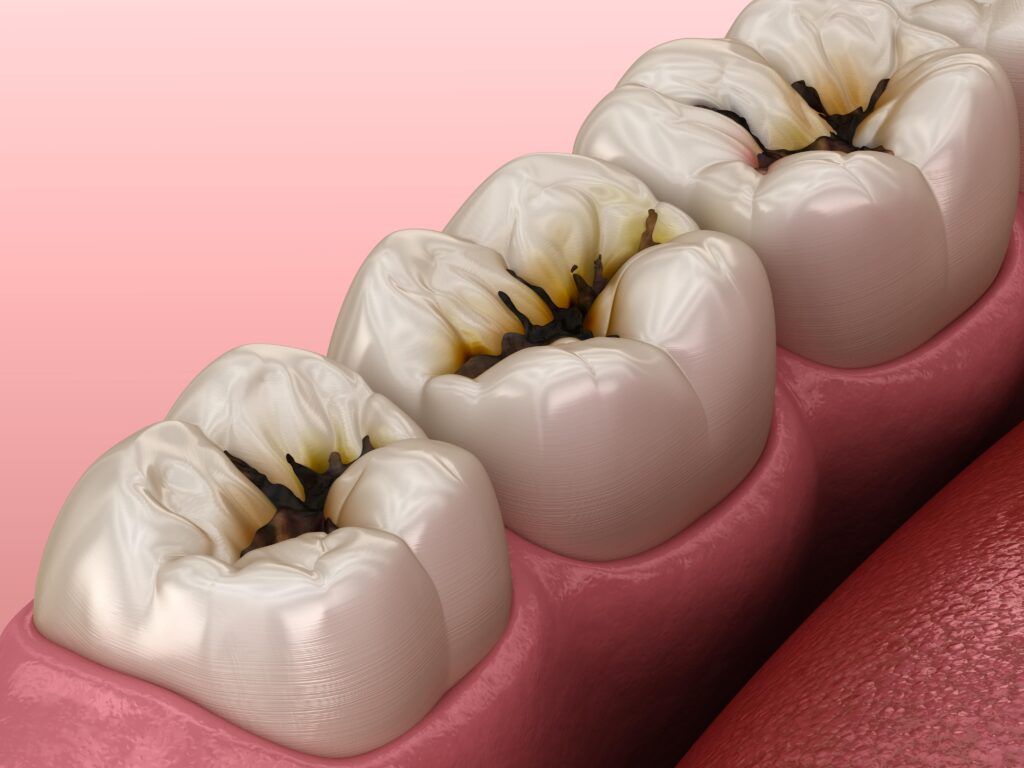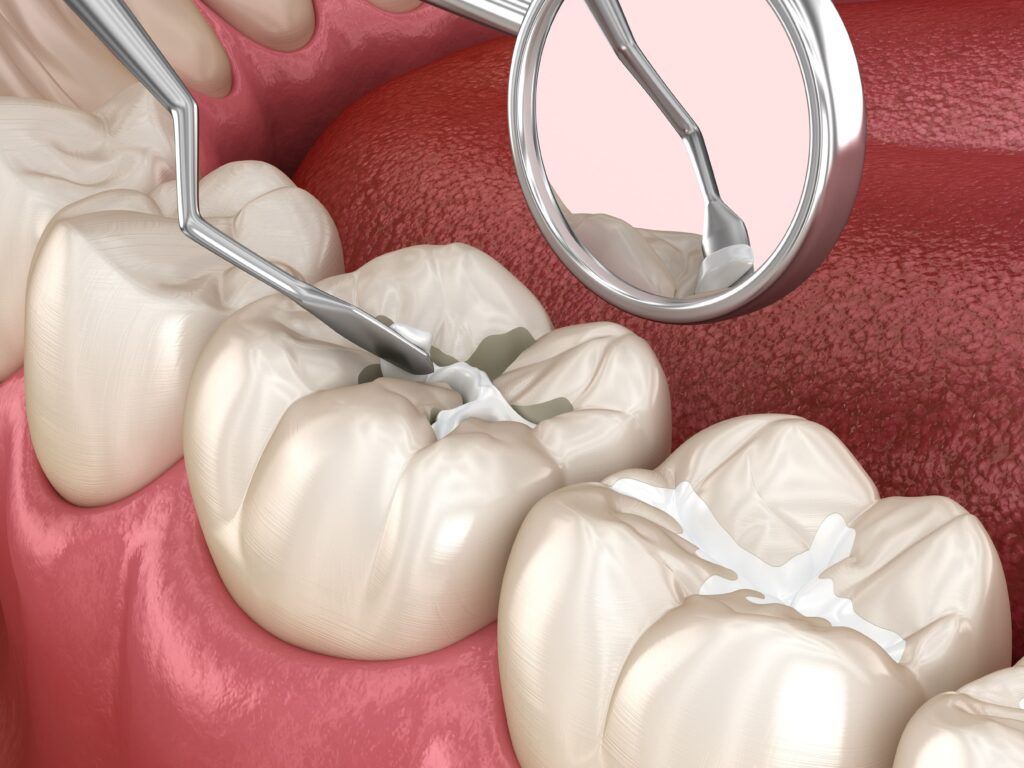When it comes to cosmetic dentistry, dental fillings play a significant role not just in treating cavities, but also in enhancing the overall aesthetics of your smile. In this blog, we’ll explore the cosmetic approach to dental fillings, the types of fillings that are used to improve the appearance of your teeth, and how cosmetic dentists carefully select and place fillings to both restore function and boost aesthetic appeal. Cosmetic dental fillings go beyond mere functionality; they are designed to look natural and improve the visual appearance of your teeth. Whether you’re looking to fix a decayed tooth or replace old, discolored fillings, understanding your options can help you make the best decision for your dental health and your smile.
When Dental Fillings are Recommended
Cosmetic dentists recommend dental fillings not only to treat tooth decay and prevent further damage but also to improve the appearance of teeth. Here are some specific scenarios where cosmetic dentists might suggest the use of dental fillings:
Cavities:

The most common reason for recommending a dental filling is to restore a tooth that has been damaged by decay, preventing further deterioration and restoring its function.
Replacing Old Fillings:
Cosmetic dentists often recommend replacing old, worn-out, or unattractive fillings, especially if they are in visible areas. Newer materials, like composite resins or porcelain, offer a more aesthetically pleasing and durable alternative to old amalgam (silver) fillings.
Chipped or Broken Teeth:
For minor chips and fractures, cosmetic dentists can use the same materials used for fillings to repair and restore the tooth’s appearance and functionality.
Closing Gaps:
Dental fillings can also be used to close small gaps between teeth. Composite resin can be added to the edges of teeth to reduce space and enhance the smile’s overall appearance.
Improving Tooth Shape:
Cosmetic fillings can be applied to alter the shape or size of teeth, making them more uniform and improving the overall look of a smile.
Tooth Discoloration:
For teeth that are severely stained or discolored and where whitening treatments might not be effective, a cosmetic dentist might use a filling material to cover the imperfections and match the natural color of the patient’s teeth.
In all these cases, the goal is to ensure that the function and the visual aspect of the teeth are maintained or improved, reflecting the dual focus of cosmetic dentistry on health and aesthetics.
Types of Dental Fillings Used in Cosmetic Dentistry
Cosmetic dentistry primarily utilizes materials that mimic the look and feel of natural teeth. Here’s a look at the most commonly used types in cosmetic dental practices:
Composite Resin Fillings:
These are the most popular choice in cosmetic dentistry due to their ability to closely match the natural tooth color. Made from a blend of plastic resins and finely ground glass-like particles, they bond directly to the tooth, creating a tight, superior fit. Composite resins are perfect for front teeth or more visible areas of your mouth.
Porcelain Fillings:
Known for their durability and color stability, porcelain fillings are another excellent cosmetic option. They resist staining better than composite resin and can be matched precisely to the natural color of your teeth. Porcelain fillings are typically called inlays or onlays and are custom-made in a lab before being bonded to the tooth.
Glass Ionomer Fillings:
While less durable than composite resins or porcelain, glass ionomer fillings have a significant cosmetic advantage for certain applications. They can be a good choice for fillings near the gum line or for children because they release fluoride, which can help prevent further decay.
How Cosmetic Dentists Place Fillings
The process of placing cosmetic dental fillings is both an art and a science, requiring meticulous attention to detail to ensure that the fillings not only fit perfectly but also look natural.
Color Matching:

The first step in a cosmetic filling procedure is to select the right shade of filling material. This is done using a shade guide or digital imaging to ensure that the filling will blend seamlessly with the surrounding teeth.
Tooth Preparation:
Similar to traditional fillings, the tooth is first cleaned and any decay is removed. The area is then shaped to prepare for the filling, but with extra care to preserve as much of the natural tooth structure as possible.
Bonding the Filling:
For composite resin fillings, the dentist applies the resin in layers, using a light specialized to harden the material quickly between layers. Porcelain fillings are usually created outside the office in a dental lab and then bonded to the tooth using a strong adhesive.
Polishing and Adjustments:
Once the filling is in place, it is polished to match the sheen of the rest of the tooth and checked for proper bite alignment. This ensures that the new filling not only looks natural but also feels comfortable and functional.
Caring for Your Dental Filling
Proper care and maintenance of your dental filling are crucial for its longevity and the overall health of your tooth. Here are some essential tips to help you take the best care of your dental filling:
1. Practice Good Oral Hygiene
- Brush Regularly: Brush your teeth at least twice a day using fluoride toothpaste. This helps prevent further decay around the filling and other teeth.
- Floss Daily: Flossing at least once a day is essential, especially around the filled tooth to remove plaque and food particles that can lead to decay.
- Use Mouthwash: An antibacterial mouthwash can help reduce bacteria that cause plaque and decay. It’s an additional layer of protection for your teeth and gums.
2. Attend Regular Dental Checkups
- Routine Visits: Visit your dentist every six months or as recommended. Your dentist can check the condition of your filling and surrounding teeth to ensure they remain in good health.
- Professional Cleanings: Regular professional cleanings help remove plaque and tartar that can’t be eliminated by brushing and flossing alone.
3. Watch What You Eat
- Avoid Hard Foods: Chewing on hard foods like ice, hard candies, and popcorn kernels can crack or dislodge your filling. It’s best to avoid biting down on these with your filled teeth.
- Limit Sugary and Acidic Foods: Sugars and acids can degrade both your natural enamel and the material of the filling. Limiting exposure to these can prevent decay and extend the life of your filling.
4. Monitor for Sensitivity or Pain
- Be Alert: It’s normal to experience some sensitivity following the placement of a new filling, especially to hot, cold, or pressure. However, this should subside within a few weeks.
- Contact Your Dentist: If you experience prolonged or severe pain, it could be a sign that the filling needs to be adjusted or replaced.
5. Use a Mouthguard if Necessary
- For Bruxism: If you grind your teeth at night, consider using a mouthguard to protect your fillings and teeth from excessive wear.
- For Sports: Wear a mouthguard during sports to protect your teeth and fillings from trauma.
6. Avoid Using Teeth as Tools
- Prevent Damage: Avoid using your teeth to open packages, bottles, or to cut things, as this can lead to chips or cracks in your fillings.
By following these care tips, you can help ensure that your dental filling remains intact and functional for many years. Regular dental visits are key to monitoring the health of your fillings and receiving professional advice tailored to your oral health needs.
Conclusion
Cosmetic dental fillings are a fantastic way to restore your teeth and enhance your smile without compromising on aesthetics. With advancements in dental materials and techniques, these fillings look more natural than ever, providing a durable and visually appealing solution to tooth decay and damage. If you are considering cosmetic fillings, consult with a cosmetic dentist to discuss your options and what type of filling material would be best suited for your specific needs.

Dr. Sadati possesses extensive experience in all aspects of advanced restorative dentistry, with an emphasis in cosmetic and implant dentistry. He has attained Accredited Fellow status in the American Academy of Cosmetic Dentistry (AACD), the most rigorous, demanding credentialing process in the world. He is the only AACD Accredited Fellow in South Florida.


